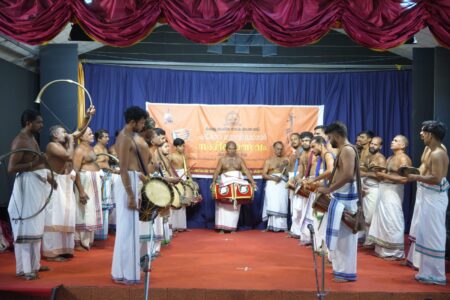Unveiling the artistry of Pulikkali, Kerala’s unique tiger dance tradition
Animal mimetic dances and flesh painting may be considered primordial art forms, but the way they are combined in Pulikkali (Tiger dance) may have no parallel in the world. On the fourth day of Onam, Swaraj Round around Thekkinkadu maidan, the nerve center of Thrissur, is virtually inundated by ‘tigers’ of all colors. Inspired by the exciting rhythm of tripuda from the indigenous percussion ensembles and encouraged by fans, including tourists from abroad, they exhibit hair-raising feats apart from mimicking the animal.
According to the late patron V. Sankara Menon, the play in Thrissur has a history of more than a century. A consummate artist by profession, Menon is credited with introducing realistic painting in Pulikkali. The play was originally introduced by Tamil-speaking Muslims as part of Muharram festivities, he had explained.
Legend has it that Ali, son-in-law of Prophet Mohammed, who was a great warrior and is portrayed by the Islamic faith as a guardian, possessed the vigor of a tiger. However, with the passage of time, the Muslims apparently lost interest in the play. The Konars and Chettiars of Tamil origin inhabiting the town took it up thereafter as they were used to Puliattam, the Tamil version of the play held during the Pongal festival.

The choreography of Pulikkali is essentially about mimicking a tiger. However, the influence of Kalarippayattu, the martial art of Kerala, is very discernible. The artists accomplish acrobatic feats on two rods supported by men, often climbing up bamboo poles and imitating the movements of the tiger.
The portrayal of a tiger by the artists has been near-perfect over the years. Apart from instances of mimicking the blood-thirsty animal, there were performers who could lift a full-grown goat by biting it by the neck. Such cruel practices, however, died out in recent years.
Behind the stripes
Painting an artist who plays the tiger is a protracted and exacting exercise that demands perseverance from both sides, the painter and the painted. On the eve of the third day of Onam, the rumble of drums starts echoing from every nook and cranny of the town, heralding the hectic and elaborate preparations for the next day’s performance.
The makeshift green rooms fill up by 9 pm as select artists are stripped and clean-shaven. Tempera powder mixed in varnish is poured into earthen bowls, and the first coat of white is applied. Designs representing the tiger in its various forms, such as the leopard, the Bengal Tiger, the Black Panther, and the zebra-like stripes of the royal tiger, appear on the body by dawn after the first coat has completely dried.
Newcomers to the game may feel queasy initially due to the smell of the paint. They are made to lie down on banana leaves. Once the painting is complete, water is sprinkled occasionally on the body to counteract the excessive heat generated by the body.

Painters are highly regarded in Pulikkali circles. While performers prefer to be painted by master painters, painters often have the final say, as their artistry is better reflected on well-built physiques. Interestingly, a sort of sentimental attachment between the painter and the artist develops.
Although Pulikkali is a non-ritualistic folklore, a strong sense of tradition and ritual persists during the preparations and performance. The painting exercise seldom begins without the traditional oil-wick lamp being lit. Artistes seek the blessings of their ‘creator,’ the painter. A visit to the nearby temple is a prerequisite before the play starts. Members of all teams break coconuts at the feet of Ganapathy at Naduvilal, a strategic point in the Swaraj Round during the exposition of the play.
Tiger dance
Jesters are a common element in various theatre forms of Kerala, both classical and folk. In Pulikkali, the jester assumes the role of a saaippu (foreigner), portraying the humorous character of a hunter by aiming his gun at every tiger in his team, including the kuttippuli (tiger cub).
Once dismissed as an obscene exercise, Pulikkali has gained significant popularity in recent times. District authorities have imposed certain restrictions on the style and duration of the presentation. Financial support from Thrissur Corporation, the Tourism Department, and the Ministry of Culture in Delhi adds to the enthusiasm of the organizing teams. Although predominantly a male activity until a few years ago, Pulikkali has also attracted a few female artists in recent years, adding to its appeal.
Pulikkali fans come from all walks of life, transcending religious, caste, and creed boundaries. Keralites working in Gulf countries often return during this period with the specific intention of participating in this annual event. Onam is a highly anticipated festival, symbolizing prosperity, and Pulikkali contributes significantly to its charm.




